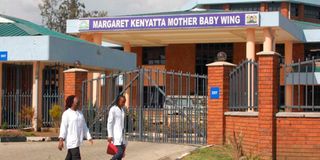How Nakuru reduced maternal mortality by 50pc

Nakuru’s Margaret Kenyatta Mother Baby Wing. In the past four years, Nakuru County has managed to reduce its maternal mortality rate by nearly 50 per cent, thanks to its investments in infrastructure and technologies.
Giving birth outside a hospital is a risky gamble, especially in cases where expectant women run into unforeseen complications.
Out-of-hospital births tend to involve less specialised intervention like caesarean section, leaving women and the unborn at high risk of injury or death when complications arise.
In the past four years, Nakuru County has managed to reduce its maternal mortality rate by nearly 50 per cent, thanks to its investments in infrastructure and technologies.
Statistics from the county’s health department show that maternal deaths dropped from 374 per 100,000 live births in 2017 to about 100 per 100,000 in January 2022.
The decline in deaths is linked to improvements made in health facilities, including revamping maternity hospitals, and availability of enough staff and equipment to provide effective services to mothers and babies.
Nakuru used to be among counties with high maternal deaths.
Quality services
To give expectant mothers quality services and hope and reduce maternal mortality, the county government pumped millions of shillings into revitalising the facilities that were abandoned by the previous administration and those in a poor state.
For instance, the administration revamped and equipped Bondeni Hospital, the oldest maternity centre in Nakuru East, to a Level Four facility.
More than 40 years old, the facility serves mothers from slums such as Kivumbini, Lake View, Kwa Rhoda, Kaptembwa, Flamingo, Kaloleni and Bondeni.
Bondeni Hospital was set up in 1952 to take care of African women living on the south side of the railway in Nakuru city.
It was purely a maternity hospital but previously did not admit first-time mothers as it could not handle complications that could arise.
In 2017, the facility was upgraded to a Level Four hospital and allocated its own budget.
Margaret Kenyatta Mother Baby Wing
Governor Lee Kinyanjui says the county sought to establish and equip maternity wings to ensure mothers do not have to rely on the Nakuru Level Five’s Margaret Kenyatta Mother Baby Wing.
"We embarked on upgrading and revitalising maternity hospitals to decongest Nakuru Level Five Hospital as well as take services closer to the people. Initially, expectant mothers had to travel all the way to the Nakuru Level Five Hospital for maternity services," he said.
"The county has allocated at least Sh6 billion to the health sector every year since 2018.
“The county health docket was allocated a whopping Sh6.6 billion in the 2019/2020 financial year, the lion’s share of the county’s total budget of Sh21.3 billion to upgrade health facilities and improve healthcare including maternity services."
Expectant mothers from remote areas of the county, including in sub-counties like Kuresoi South, Kuresoi North, Subukia and Molo, had to seek services at Nakuru Level Five Hospital.
However, this is now a thing of the past, with the revamping of maternity wings in hospitals in Bahati, Molo, Olenguruone, Naivasha and other far-flung areas.
200 deliveries
At the Bahati hospital, the Nation learnt that up to 200 babies are delivered every month, up from about 30 initially.
"Before the Bahati Sub-County Hospital was given a facelift and equipped better, we used to travel all the way to the Nakuru Level Five Hospital to seek prenatal and postnatal services. However, this has changed and the services are available at the Bahati hospital," said resident Mary Kamau.
Naivasha Sub-County Hospital also received a Sh330 million facelift.
The Sh60 million ultramodern hospital has started offering maternity and surgery services.
The revamped maternity wings in various sub-counties have supplemented the 250-bed capacity Margaret Kenyatta Mother Baby Wing at Nakuru Level Five opened by First Lady Margaret Kenyatta in 2018.
Biggest in Rift Valley
The Sh450 million state-of-the-art maternity wing is the biggest in the larger Rift Valley region, the largest after Nairobi County's Pumwani Hospital.
It also serves Bomet, Baringo, Narok, Kericho, Samburu, Laikipia and Nyandarua counties.
Nakuru has also embraced technology to drastically reduce maternal deaths.
The introduction of smart watches that monitor the blood pressure of expectant mothers, for instance, has helped lower maternal deaths.
The devolved unit has partnered with Kabarak University to introduce the technology that monitors and identifies mothers with hypertensive disorders during pregnancies.
The use of smart watches has helped increase surveillance, early detection and identification of women who may develop the condition early enough for management.
"Nakuru County is determined to drastically reduce maternal deaths. The collaboration has helped reduce cases of women dying from pre-eclampsia and eclampsia, which are among the highest causes of death and complications at delivery," Mr Kinyanjui said.
Pre-eclampsia is a disorder characterised by high blood pressure and a protein in the urine causing seizures and loss of consciousness and often leads to eclampsia that causes excessive bleeding and other complications and even death in extreme cases.
These conditions happen to pregnant women across all ages, said county reproductive health coordinator Clara Kerich.
"Health workers in county facilities were trained on the new technology and data collected will be used to improve antenatal care and treatment of hypertensive disorders during pregnancy," Ms Kerich said.
The county government has also hired at least 600 medics in the past few years, including nurses, midwives and childbirth and childcare specialist doctors.
It has also invested in a fleet of 40 ambulances that are centrally managed. Five of them have advanced life-support equipment.





